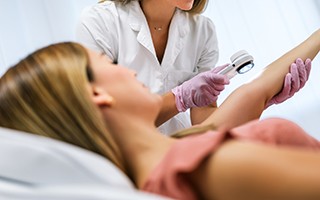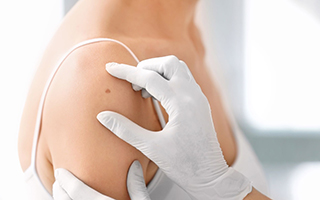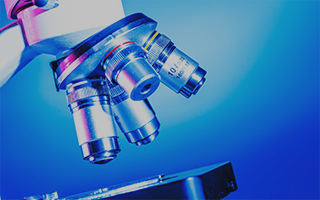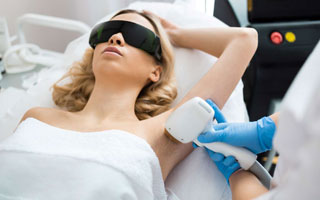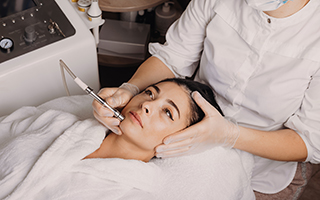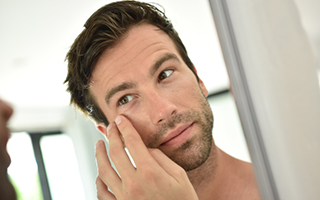Cysts and Lipomas
Treatments for Abnormal Skin Bumps in Bryn Mawr, Newtown Square, Philadelphia, and the Main Line
- Home
- Medical Dermatology
- DERMATOLOGY CONDITIONS
- Cysts, Lipomas
Cysts are lumps located beneath the skin surface that contain fluid or retained skin material and are often seen or felt. They may have a visibly dilated pore on the surface. These are common and usually non-cancerous, so they can often be left alone—but they may require treatment if they are inflamed and causing pain. If you’re unsure whether a bump on your skin needs treatment and want a proper diagnosis to determine if it is a cyst, the Bryn Mawr Skin & Cancer Institute can help. If you’ve noticed a new bump on your skin, even if it isn’t causing any discomfort, we recommend seeing one of our dermatologists.
Lumps beneath the skin that are comprised of fat cells are known as lipomas. While lipomas can develop anywhere, they are especially common on the torso, thighs, and buttocks. Lipoma surgery is available to remove these fatty lumps.
For more information on identifying and treating cysts, contact Bryn Mawr Skin & Cancer Institute. Please BOOK ONLINE, call 610.525.5028, or Contact Us.
What Causes Cysts?
The development of cysts is often associated with blocked sebaceous glands, abnormal shedding of skin contents, skin trauma including piercings and infections. There can also be a genetic predisposition to developing cysts.
What Are the Symptoms of Cysts?
Cysts are often asymptomatic. They can remain asymptomatic forever. However, if a cyst becomes inflamed it will become red, painful and increase in size. Pus may accumulate in the cyst leading to spontaneous rupture. Dermatologists surgically drain inflamed cysts that have not ruptured on their own.
What Are the Most Common Types of Cysts?
Cystic Acne
Acne is a common dermatological condition that occurs when bacteria, dead skin, and oil become trapped in a pore, creating a bump in the skin. In more severe cases, the follicle ruptures and the surrounding skin becomes inflamed resulting in cystic acne. Cystic acne causes large, painful, and pus-filled bumps that may scar the skin.
Epidermoid Inclusion Cysts
Epidermoid inclusion cysts, often referred to as sebaceous cysts, can vary in size from small to large and most commonly appear on the face, head, neck, back, or genitals. They occur due to an abnormal accumulation of keratin below the skin’s surface. They are skin colored, tan, or yellowish, but may become red and inflamed, as noted previously.
Treatment Options for Cysts
Mildly inflamed acne and epidermal inclusion cysts can be treated with topical and oral antibiotics and injections with a corticosteroid. Warm compresses applied at home can help decrease inflammation and speed the healing process. More inflamed acne and epidermal inclusion cysts may require surgical incision and drainage along with the treatments described previously. If an acne or epidermal inclusion cyst continues to become inflamed, a complete surgical excision of the area is performed when the cyst is quiescent (not inflamed). Do not pick or squeeze acne or epidermal inclusion cysts as this increases the risk of inflaming them.

Meet Our Dermatologists &
Certified Physician Assistants
Our board-certified dermatologists & PA-Cs are dedicated to detecting and treating skin cancers. We treat the full spectrum of skin diseases. Our Mohs and Plastic Surgery practices are integrated, and offer patients the most advanced skin cancer treatment, delivering superior outcomes.
Treatment Options for Lipomas
Lipomas are typically asymptomatic and tend not to become inflamed as often as epidermal inclusion cysts. However, if a lipoma is growing, surgical excision is the treatment of choice. Lipomas may reoccur after surgery.
Explore options for treatment and prevention of cysts at Bryn Mawr Skin & Cancer Institute serving Bryn Mawr, Newtown Square, and Philadelphia. To schedule an appointment, Please BOOK ONLINE, call 610.525.5028, or Contact Us.




